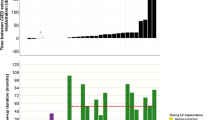Abstract
Heart transplantation (HT) in patients with prior cardiovascular implantable electronic devices (CIEDs) is becoming more common, in parallel with the increased use of CIEDs for patients with advanced heart failure. Complete removal of CIED components during HT is not always feasible, and it is thus surprising that the literature addressing the implications of retained CIED components is limited. Indeed, there are neither guidelines nor consensus regarding the need for removal of these CIED fragments. This issue is nonetheless becoming important in light of the increase in the percentage of HT candidates having CIEDs, on the one hand, and newer therapeutic immunosuppressive protocols with higher bacterial infection potential, on the other. Thus, with the aim to study the implications of retained CIED fragments as a step towards establishing a therapeutic approach for the unique population of HT recipients with CIED remnants, we present here a case series of HT patients with retained CIED fragments who developed complications of infections together with a review of the available literature.
Similar content being viewed by others
References
2013 ESC Guidelines on cardiac pacing and cardiac resynchronization therapy: the task force on cardiac pacing and resynchronization therapy of the European Society of Cardiology (ESC). Developed in collaboration with the European Heart Rhythm Association (EHRA). Eur Heart J. 2013;34:2281–2329.
Mehra MR, Yancy CW, Albert NM, et al. Evidence of clinical practice heterogeneity in the use of implantable cardioverter-defibrillators in heart failure and post-myocardial infarction left ventricular dysfunction: findings from IMPROVE HF. Heart Rhythm. 2009;6:1727–34.
Kuśmierski K, Przybylski A, Oręziak A, Sobieszczańska-Małek M, Kołsut P, Różański J. Post heart transplant extraction of the abandoned fragments of pacing and defibrillation leads: proposed management algorithm. Kardiologia Polska. 2013;71:159–63.
Abraham P, Caliskan K, Szili-Torok T. High incidence of unexpected defibrillation coil retention during orthotopic heart transplantation. J Heart Lung Transplant. 2012;31:909–11.
Martin A, Voss J, Shannon D, Ruygrok P, Lever N. Frequency and sequelae of retained implanted cardiac device material post heart transplantation. Pacing Clin Electrophysiol. 2014;37:242–8.
Kim J, Hwang J, Choi JH, et al. Frequency and clinical impact of retained implantable cardioverter defibrillator lead materials in heart transplant recipients. PLoS ONE. 2017;12:e0176925.
Austin CO, Landolfo K, Parikh PP, Patel PC, Venkatachalam KL, Kusumoto FM. Retained cardiac implantable electronic device fragments are not associated with magnetic resonance imaging safety issues, morbidity, or mortality after orthotopic heart transplant. Am Heart J. 2017;190:46–53.
Alvarez PA, Sperry BW, Perez AL, et al. Burden and consequences of retained cardiovascular implantable electronic device lead fragments after heart transplantation. Am J Transplant. 2018;18:3021–8.
Holzhauser L, Imamura T, Nayak HM, et al. Consequences of retained defibrillator and pacemaker leads after heart transplantation—an underrecognized problem. J Card Fail. 2018;24:101–8.
Pettit SJ, Orzalkiewicz M, Nawaz MA, Lewis C, Parameshwar J, Tsui S. Retained pacemaker and implantable cardioverter–defibrillator components after heart transplantation are common and may lead to adverse events. Europace. 2018;20:1312–7.
Koshy AN, Nanayakkara S, McGiffin DC, Martin J, Bergin P, Mariani JA. Retained defibrillator leads following orthotopic heart transplantation. Int J Cardiol. 2016;215:87–9.
Kusumoto FM, Schoenfeld MH, Wilkoff BL, et al. 2017 HRS expert consensus statement on cardiovascular implantable electronic device lead management and extraction. Heart Rhythm. 2017;14:e503–e551551.
Durante-Mangoni E, Vitrone M, Mattucci I, Caprioli V, Maiello C. Infection of retained defibrillator lead fragment after heart transplant. Clin Pract. 2017;7(2):857.
Bhakta M, Sorajja D, Scott LR, Altemose GT. Asymptomatic cardiac embolism of a retained ICD lead component in a patient after orthotopic heart transplantation. J Innov Card Rhythm Manag. 2011;2:354–7.
Binner-Oussenek K, Strotdress E, Dähnert I, Barten M, Binner C, Borger M, Mohr FW. Unusual complication of a retained pacemaker insulation sheath causing severe tricuspid regurgitation after heart transplantation. Ultraschall in Med. 2013;34:WS_SL15_04.
Luehr M, Daehnert I, Mohr FW, Barten MJ. Three-dimensional computed tomography imaging of an implantable cardioverter-defibrillator lead fragment in the left ventricle of a heart transplant followed by successful transarterial extraction with a snare catheter. Interact Cardiovasc Thorac Surg. 2012;15:158–60.
Rodriguez C, Munoz P, Rodriguez-Creixems M, Yaez JF, Palomo J, Bouza E. Bloodstream infections among heart transplant recipients. Transplantation. 2006;81:384–91.
Hussein AA, Tarakji KG, Martin DO, et al. Cardiac implantable electronic device infections. JACC Clin Electrophysiol. 2017;3:1–9.
Blomström-Lundqvist C, Traykov V, Erba PA, et al. European Heart Rhythm Association (EHRA) international consensus document on how to prevent, diagnose, and treat cardiac implantable electronic device infections-endorsed by the Heart Rhythm Society (HRS), the Asia Pacific Heart Rhythm Society (APHRS), the Latin American Heart Rhythm Society (LAHRS), International Society for Cardiovascular Infectious Diseases (ISCVID) and the European Society of Clinical Microbiology and Infectious Diseases (ESCMID) in collaboration with the European Association for Cardio-Thoracic Surgery (EACTS). Europace. 2019. doi: https://doi.org/10.1093/europace/euz246. [Epub ahead of print]
Sparkes T, Lemonovich TL. Interactions between anti-infective agents and immunosuppressants—Guidelines from the American Society of Transplantation Infectious Diseases Community of Practice. Clin Transplant. 2019;33(9):e13510.
Funding
This work did not require any external funding.
Author information
Authors and Affiliations
Corresponding author
Ethics declarations
Conflict of interest
On behalf of all authors, the corresponding author states that there is no conflict of interest.
Ethical standards
A written consent was obtained from the patients for publication.
Rights and permissions
About this article
Cite this article
Fardman, A., Ram, E., Lavee, J. et al. Complications of retained pacemaker hardware in heart transplant recipients: case series and review of the literature. Infection 48, 635–640 (2020). https://doi.org/10.1007/s15010-020-01410-x
Received:
Accepted:
Published:
Issue Date:
DOI: https://doi.org/10.1007/s15010-020-01410-x



